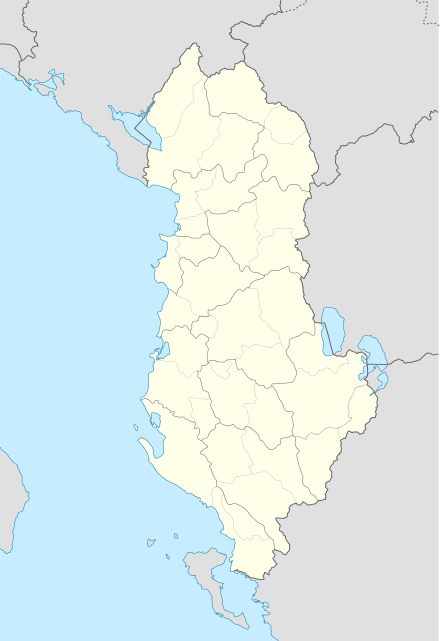Dovolan
| Dovolan Доволан | |
|---|---|
| Village | |
 Dovolan | |
| Coordinates: 41°37′16″N 20°26′54″E / 41.62111°N 20.44833°ECoordinates: 41°37′16″N 20°26′54″E / 41.62111°N 20.44833°E | |
| Country |
|
| County | Dibër |
| Municipality(s) | Dibër |
| Time zone | UTC+1 (CET) |
| • Summer (DST) | UTC+2 (CEST) |
Dovolan (Macedonian: Доволан/Dovolan) is a village in the former Maqellarë Municipality in Dibër County in northeastern Albania. At the 2015 local government reform it became part of the municipality Dibër.[1] It is located near the Macedonian border, on the mountain Dešat.
History
A demographic study published in 1878, reflecting statistics of the male population from 1873, stated that the village's population consisted of 40 households with 94 Bulgarian Christians and 53 Slavic Muslims.[2]
Two members of the Macedonian-Adrianopolitan Volunteer Corps, Kiril Martinov and Kosto Ivanov, were natives of Dovolani.[3]
During the first World War occupying Austro-Hungarian forces conducted a census (1916-1918) of parts of Albania they held and of Dovolan its ethnic demographics they recorded 259 Albanians, 44 Bulgarians, 136 others, 5 Romani while its religious composition was 258 Muslims and 51 Orthodox Christians.[4] Linguists Klaus Steinke and Xhelal Ylli consider the overall census results to be accurate and reflective of much of the ethnic and religious demographics of the area during that time[4], however noting that the then identity of the Orthodox Slavic speaking populace was fluid as reflected in census declarations.[5] Toward the end of the 1920s the Orthodox Slavic speaking population was located in only two villages of the Maqellarë area, Kërçisht i Epërm and Herebel while in the 1930s the population decline of Orthodox Slavophones continued.[6]
A 1930 report listed the village of Dovolan as having 50 houses.[7]
During the 2000s linguists Klaus Steinke and Xhelal Ylli seeking to corroborate villages cited in past literature as being Slavic speaking carried out fieldwork in villages of the area.[5] Linguists Steinke and Ylli also noted that unlike the Gollobordë region, the villages of the Maqellarë administrative unit area do not have any Muslim Slavic speaking inhabitants.[5]
References
- ↑ Law nr. 115/2014
- ↑ „Македония и Одринско. Статистика на населението от 1873 г.“ Македонски научен институт, Sofia, 1995, стр.172-173.
- ↑ „Македоно-одринското опълчение 1912-1913 г. Личен състав“, Главно управление на архивите, 2006
- 1 2 Steinke & Ylli 2008, p. 249. "Bin Vergleich der beiden oben erwähnten Quellen mit der von den Österreichern während des ersten Weltkrieges durchgeführten Volkszählung, die zweifellos glaubwürdig ist, da sie sich auf eine direkte Befragung der Bevölkerung in den Jahren 1916-1918 stützt, zeigt Unstimmigkeiten."; p.250. "Albaner A, Bulgaren B, Zigeuner Z, Sonstige S, Zigeuner Z, Musl. M, Orth. O; Gemeinde Maqellara: ... Dovolani 259 A, 44 B, 5 Z, 258 M, 51 O"
- 1 2 3 Steinke, Klaus; Ylli, Xhelal (2008). Die slavischen Minderheiten in Albanien (SMA): Golloborda - Herbel - Kërçishti i Epërm. Teil 2. Munich: Verlag Otto Sagner. p. 252. ISBN 9783866880351. p. 252. "Anders als in den Dörfern Gollobordas sind in diesem Gebiet keine Spuren von slavophonen Muslimen zu finden. Die ethnische Zugehörigkeit der kleinen orthodoxen und slavophonen Gruppe ist außerdem nicht einfach anzugeben. Bezeichnend sind in diesem Zusammenhang die Ergebnisse der 1916 von den Österreichern durchgeführten Volkszählung.... Über die ethische Identität der slavophonen Orthodoxen scheint es keine klare Vorstellung gegeben zu haben.... noch die ausführlichen Befragungen unserer Informanten sowie anderer Bewohner des Gebietes haben irgendwelche Hinweise auf weitere Orte mit slavophonen Einwohnern in diesem Bereich ergeben."
- ↑ Steinke & Ylli 2008, p. 251. "Seit Ende der 20er bis Anfang der 30er Jahre findet man nur noch Angaben für Gorno Krăčišta und Ărbele. Die demographische Entwicklung der 30er Jahre, nämlich der Rückgang des slavophonen Bevölkerungsanteils, der meist aus Orthodoxen bestand, hat sich fortgesetzt, wie die aktuell ermittelten Zahlen zeigen."
- ↑ Поверителен рапорт №54 на Сребрен Поппетров
